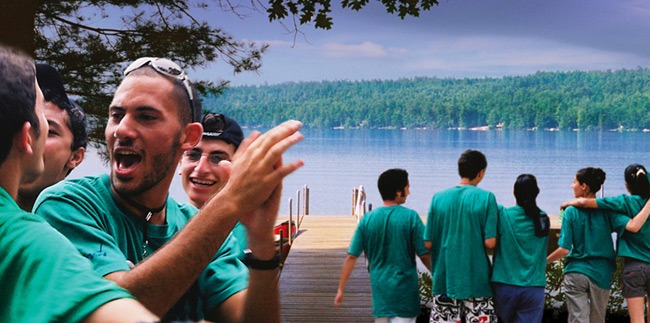
Power of Peace
Written by Margaret Tranggono | Posted by: Anonymous
Israelis shake hands with Palestinians. Indians sit next to Pakistanis. Afghans meet Americans. It may seem like an impossible dream, but the organization Seeds of Peace has been fostering just that for over 10 years. Teenagers from across the world attend their summer camp in Maine to learn the tools of tolerance and coexistence, to break the cycles of stereotypes and violence in their own lives, and to collaborate and to cooperate in finding a path to friendship.
Inspired by the teens, filmmakers Joseph Boyle and Marjan Safinia (Marj) set out to create the documentary "Seeds" featuring the experiences and stories of the teenagers at the 10th Seeds of Peace Camp in 2002. Here they talk about the process from financing the film to attracting a distributor.
MT: How did you get into filmmaking?
Boyle: In college, I joined the Media Arts program because the things that were most important to me were music and art and creative forms. I don’t mean art as in I was going to museums or anything like that. For me, filmmaking was the most complete form of this expression.
Safinia: I’m a first generation immigrant from Iran. I grew up in London, and never even considered filmmaking as an occupation until I visited a friend in Los Angeles for summer vacation, and watched him make his students films. I thought it would be so cool to study film for four years and live in LA, instead of doing interminable translations in a dreary British town. I applied to USC, got in, and moved here to study.
With a close friend and partner, Parisa Taghizadeh, I set out to make my first doc, "But You Speak Such Good English," a funny and intimate short exploring aspects of the first-generation Iranian immigrant experience in London. Making that film was the best kind of "film school" imaginable.
MT: What inspired you to do this story? How did you find out about the Seeds of Peace camp in Maine?
Safinia: I was living in New York at the time, and a friend invited me to a ballet called "Stars of the 21st Century," featuring the top dancers from ballet companies around the world. Little did I know that it was a fundraiser for Seeds of Peace. When I got home, I drafted a letter to John Wallach, the founder of SOP, and shortly thereafter we went in to meet with him.
I was moved by the effort these brilliant teenagers were willing to put in to transforming their countries into better places for the future. Coming from a messed-up country, which I had all but abandoned completely, it felt really important that these kids were being offered some help and support in trying to fix the major issues in their societies, instead of walking away from them. Any one of these brilliant kids could get scholarships to come and study in the US. Any one of these kids could emigrate, and leave that mess behind them, but here they were, willing to fight to make it better. It resonated very deeply with me.
Boyle: For me it was all about the subject matter and the place in time that the world was at. The overwhelming negativity towards the state of the world is causing all of us stress and that stress creates more stress and things continually look grimmer and grimmer. For me, this was an antidote of sorts to the negativity surrounding the world in general and these conflicts in particular. It was a catharsis for me personally as well, especially with the post 9-11 world psyche. I felt that doing something that focused on creating hope in the most negative of situations was the most natural thing to do.
MT: What kind of preparations did you have before shooting? What were some of the trials and tribulations?
Boyle: We had to figure out the best way to deal with the subject, and how we could best translate the experience to the audience. We also knew there would be restraints in trying to tell the story of an experience that happens to a number of different characters over a very short period of time. So, stylistically, we built in situations that would allow us to capture footage in as many ways as possible. We let the kids take the cameras, and we even let them shoot us. We built the "Diary Booth" which allowed them 24-hour access to a camera, and it turned out to be the space that a lot of them felt the most safe in. This is where a lot of the magic happens, actually. Watching the booth tapes was like opening a present because we didn’t know what we would find.
Safinia: Five weeks in which to raise our production budget, put a crew together, buy equipment, organize shooting and travel, not to mention figure out our story and creative approach. It was hell — long days and nights and much pacing around the room on the phone. Thankfully, we found a wonderful producer, Hana Alireza, who was instrumental in helping us fundraise. That was really the biggest hurdle.
Also, the thing about documentaries is that you just can’t plan it too much. Magic is what unfolds in front of the camera, and the best trick is to open your eyes, ears and mind to what is happening in front of you.
MT: What do you want the audience to take away from your film?
Boyle: Believe in the power of individuals to make a difference. The characters from the film face situations that most of us outside the conflicts will never be able to understand. It’s not only that their lives are in danger, but also the extreme societal pressure to uphold the status quo of conflict itself and the roles in which they are expected to play in the conflict. They are teenagers who are thinking "outside the box" from within, and defining for themselves how they relate to their conflicts and what they can do on a personal level to get through it or even change it. They set out to create a world, but more importantly, a SELF that they want to live in. That is incredibly inspiring.
Safinia: That change is possible. That these kids deserve better lives. That real people with real lives are involved in these conflicts. That people you "hate" might be more similar than you think. That in order to reach compromise, you’re going to have to face some of the stuff on your own side and take responsibility for it. That you should not believe what you read and hear about other people, but should be willing to ask them and learn for yourself. In the words of one of the kids, "Don’t dismiss others ideas because they don’t suit you. Fight hard to know more."
MT: How did you go about accomplishing the fundraising process? You seem to have had major success in that area.
Safinia: Here’s my theory on fundraising: If you need money, ask rich people. It’s as simple as that. We simply put together a professional package about the film, and presented it to select individuals with money, whom we thought would really care enough to get involved.
Present it well. Use images, well-thought out layout. Go nuts and buy heavy expensive paper, not crappy copier paper. Have a nice business card designed. If you’ve shot footage, put a really good sample together. Package it on a slick DVD. Make a sticker for it. Make a cover for it. Make people believe that if they give you money, you will spend it wisely.
MT: Lessons learned from the project?
Boyle: Producing and directing at the same time is obviously much harder than doing one or the other. What I didn’t fully appreciate was how emotionally difficult it is to switch gears multiple times within the same day.
Safinia: I’ve learned much more about my craft, and about the marketplace I work in, about the reality of these conflicts, about selling my work. And I’ve learned the value of working with excellent partners and collaborators.
MT: Where can one view your film?
We will be premiering the film at the AFI / SilverDocs Documentary Festival at the Opening Night Film on June 15th. After that, we should be screening in festivals around the country, and will hopefully secure a distribution deal to bring the film to theaters in major cities, followed by a television broadcast. If people are interested in following the project, they can check out our website at www.mergemedia.tv.
MT: Any words of wisdom to aspiring filmmakers?
Safinia: Trust your gut. Be true to what you set out to do. Be humble. Work hard. Love what you’re doing because you will live, eat, breathe, and dream about it for years. Remember that doing this for a living is a privilege. Treat it as such. Keep pushing your personal boundaries. Filmmaking is as much about self-discovery as anything else. Don’t give up.
Boyle: I like what Marj said — that doing any work that you love is a privilege and realize that there are many, many, many sacrifices you will have to make to do it. If that is an equation that you can live with, then you have no choice but to be true to yourself and go for it.
More about the film at: http://www.seedsthemovie.com.












